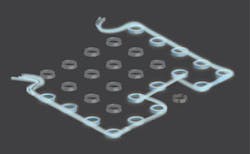Gaithersburg, MD--Research performed at the Joint Quantum Institute of the National Institute of Standards and Technology (NIST) and the University of Maryland, together with Harvard University may make it possible to steer particles of light accurately through computer chips. The scientists say the work—based on using multiple rows of photonic resonators—not only may lead to more efficient information processors on our desktops, but also could offer a way to explore a particularly strange effect of the quantum world known as the quantum Hall effect in which electrons can interfere with themselves as they travel in a magnetic field.
"We run into problems when trying to use photons in microcircuits because of slight defects in the materials chips are made from," says Jacob Taylor, a theoretical physicist at NIST and JQI. These defects are particularly problematic when they occur in photon delay devices, which slow the photons down to store them briefly until the chip needs the information they contain. Delay devices are usually constructed from a single row of tiny resonators, so a defect among them can ruin the information in the photon stream. But the research team perceived that using multiple rows of resonators would build alternate pathways into the delay devices, allowing the photons to find their way around defects easily.
Optical fibers make it possible for dozens of independent phone conversations to travel long distances along a single glass cable by, essentially, assigning each conversation to a different color--each narrow strand of glass carrying dramatic amounts of information with little interference. But while it is easy to send photons far across a town or across the ocean, scientists have a harder time directing them to precise locations across short distances--say, a few hundred nanometers--and this makes it difficult to use photons as information carriers inside computer chips.
Lead author Mohammad Hafezi says the prospect of investigating the quantum Hall effect with the same technology also has great scientific appeal. "The photons in these devices exhibit the same type of interference as electrons subjected to the quantum Hall effect," says Hafezi, a research associate at JQI. "We hope these devices will allow us to sidestep some of the problems with observing the physics directly, instead allowing us to explore them by analogy."
The corresponding physics is rich enough that its investigation has already resulted in three Nobel Prizes, but many intriguing theoretical predictions about it have yet to be observed.
SOURCE: NIST; www.nist.gov/pml/div684/photon-082211.cfm

